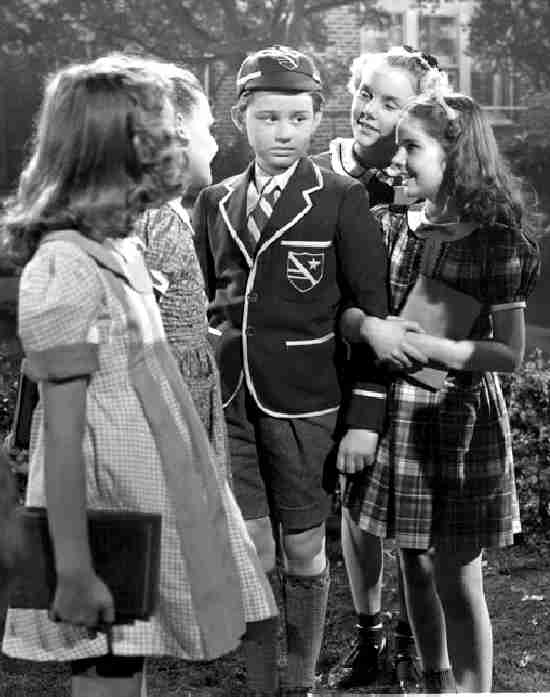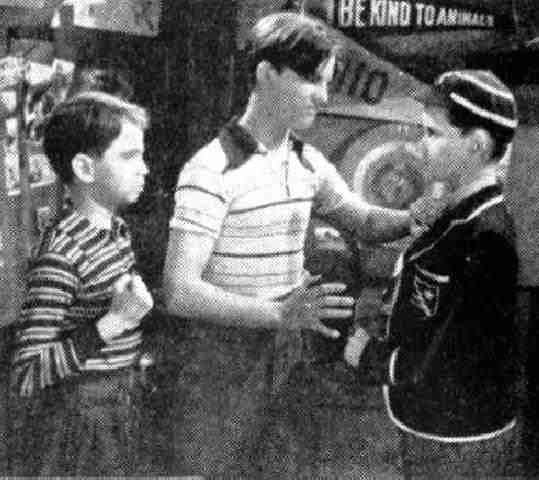
Figure 1.--English World War II war refugee find that the girls in his new American town are most imopressed with his manners and clothes, but the boys not nearly as taken with him.


Figure 1.--English World War II war refugee find that the girls in his new American town are most imopressed with his manners and clothes, but the boys not nearly as taken with him. |
This film was released after America entered World War II, although it was begun while Britain fought the Germans alone. The German Blitz of London engendered great sympathy for the British while America was still officially neutral. English boy refugee Hugh Aylesworth--a very polite English boy who has been evacuated to America during the German bombing ("the Blitz") of London. Hugh is welcomed by Mr. and Mrs. Andrews, a typical small town American family. They of course are charmed by their young guest's
impeccable English manners. Less impressed is the Andrew's own son Don. He not not only feels rejected, but looks on Hugh as an interloper and a constant irritant to his once tranquil uncomplicated American life style. Hugh's school uniform, complete with cap, blazer, tie, short pants, and kneesocks certainly does nor raisre Hugh;s stock in Don's eyes. The girls are, however, most impressed. in short pants and blazer comes to an American small town. He is teased about his shorts by the local boys, all in long pants of course. Roddy was 13 or 14 at the time, although he looked younger. You wonder if this might have actually happened to him when he came to the States in 1941. Hugh in typical English fashion manages to prove himself a "regular guy" when he helps Dom deal with a particularly thraentening bully at school (Stanley Clements). Unfortunately we have necer seen the film on shown on TV, unlike many of Roddy's other films.
This film was released after America entered World War II, although it was begun while Britain fought the Germans alone. After the German offensive in the west, France fell in June. By Juky, the Germans had begun preparations for an air offensive against the British. Ar first the Lufwaffe concentated in the Royal Air Force, but by September, Hitler decided to concentate in London and other English cities. The German Blitz of London engendered great sympathy for the British while America was still officially neutral. Even before the Blitz began, the British began evacuating London children to the country side. At first when it looked like Britain might fall, children were evacuated to Ametica and Canada. After some were loss to U-boat attacks, the evacuations were restricted to safer areas in Britain. Several good movies and TV programs deal with this subject. The titles allude me just now, but I will add them here as they come to mind. One excellent film about the Blitz is Hope and Glory, although the mother changes her mind about evacuation at the last minute.
Roddy McDowall stared in this film, but it was one of his major film appearances. It was directed by Harold D. Schuster.
The cast included: Roddy McDowall, Jane Darwell, Stanley Clements, Katherine Alexander, Donald Douglas, and Freddie Mercer.
Roddy McDowall was one of the major child stars of the early 1940s. His
performance in films like How Green Was My Valley and Lassie Come
Home were classics. He dressed as an English boy in short pants for his
roles, but also wore shorts from day to day even after coming to America.
This was at a time when most American boys, especially boys his age did not
wear shorts. He said that he felt that there was a conspiracy to keep him a
child. Fairly large sums of money were involved. His transition to teenage
parts did not go well. He continued making films, but was no longer a star.

Figure 2.--The boys in Hugh's new American town were not nearly as impressed with him. One wonders if he might not have had an easier time in Germany. |
English boy refugee (Roddy McDowell) stars as Hugh Aylesworth--a very polite English boy who has been evacuated to America during the German bombing ("the Blitz") of London. Hugh is welcomed by Mr. and Mrs. Andrews (Don Douglas and Katherine Alexander), a typical small town Anerican family. They of course are charmed by their young guest's
impeccable English manners. Less impressed is the Andrew's own son Don (Freddie Mercer). He not not only feels rejected, but looks on Hugh as an interloper and a constant irritant to his once tranquil uncomplicated American life style. He is teased about his English short pants by the local boys, all who wear long pants of course. Hugh with typical English pluck manages to prove himself a "regular guy" when he helps Dom deal with a particularly thraentening bully at school (Stanley Clements). This was mild, however, to his experience in a Welsh schoolyard in How Green is My Valley.
Hugh's school uniform, complete with cap, blazer, tie, short pants, and kneesocks certainly does nor raise Hugh's stock in Don's eyes. Roddy's uniform was not one worn by the average British school boy. It looks like a private preapratory school uniform. Most English primary schools at the time did not have uniforms. It was common, however, for boys to wear caps and short pants suits tomschool. The girls are, however, most impressed. in short pants and blazer comes to an American small town. Roddy was 13 or 14 at the time, although he looked younger. You wonder if this might have actually happened to him when he came to the States in 1941.
Unfortunately we have never seen the film on shown on TV, unlike many of Roddy's other films. I'm not sure why this film has not been shown on television.
Navigate the Boys' Historical Clothing Web Site:
[Return to the Main "Om-Oz" movie page]
[Return to the Main alphabetical movie page]
[Return to the Main movie page]
[Return to the Main Roddie McDowal page]
[Introduction]
[Activities]
[Bibliographies]
[Biographies]
[Chronology]
[Clothing styles]
[Contributions]
[Countries]
[Boys' Clothing Home]
